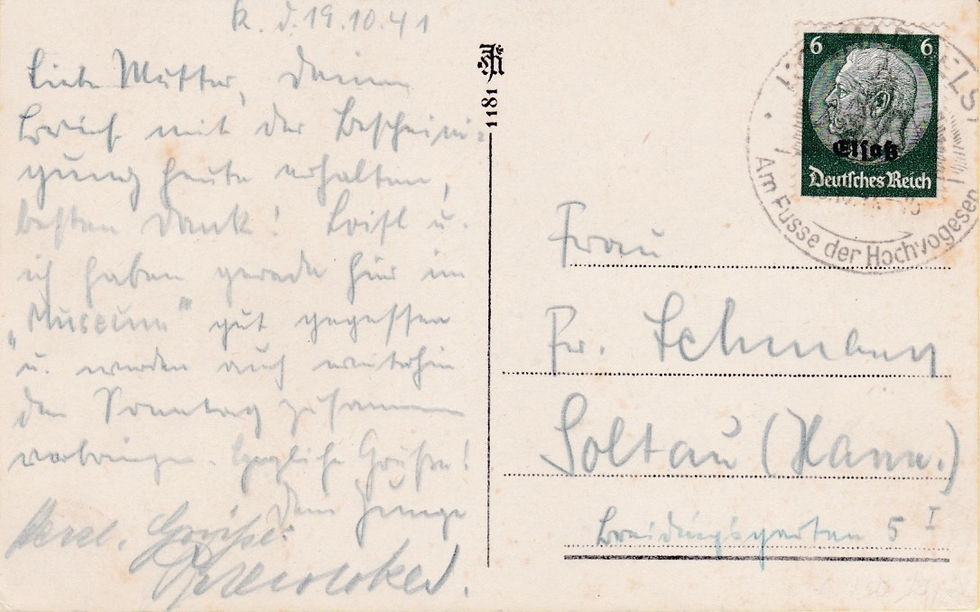19th October 1941
Kolmar



Postcard sent from Kolmar depicting 'Adolf Hitlerstrasse' (now Avenue de la République, Colmar). Ref: 19.10.1941
Link to the same view today
Kolmar
Colmar (German: Kolmar) is a city and commune in the Haut-Rhin department and Grand Est region of north-eastern France. The third-largest commune in Alsace (after Strasbourg and Mulhouse), it is the seat of the prefecture of the Haut-Rhin department and of the subprefecture of the Colmar-Ribeauvillé arrondissement.
With the rest of Alsace, Colmar was annexed by the newly formed German Empire in 1871 as a result of the Franco-Prussian War and incorporated into the Alsace-Lorraine province. It returned to France after World War I according to the 1919 Treaty of Versailles, was annexed by Nazi Germany in 1940, and then reverted to French control after the battle of the 'Colmar Pocket' in 1945.
Source: Wikipedia

The 2nd February 1945 is a key date in the city´s history. For the citizens of Colmar, it marked the end of the war, even if fighting continued for a time elsewhere in Europe. The battle of the Colmar pocket was the last to be fought on French soil. Three whole months would pass between the liberation of Strasburg and the one of Colmar, with desperate German resistance holding up the Allied advance before finally collapsing.
The operation was supposed to be done in a short period of time. In November 1944, General De Lattre de Tassigny´s 1st Army launched a crushing offensive in the south of Alsace that broke through the German front line to take Belfort and then pushed on to the Rhine, liberating Mulhouse on 21st November. Two days later, General Leclerc´s 2nd armoured division entered Strasburg, after a campaign that had started in Koufra in Chad. The liberation of Alsace then seemed to be a question of days or even hours. The panic-stricken Nazi authorities in Colmar had already fled the city and the Colmarians were getting ready to celebrate their liberation.
But then the Americans wavered and De Lattre decided to call a halt to his offensive in the plain of Alsace and to withdraw the 5th armoured division to the rear of the French lines. The German reaction was swift. Operation Nordwind was launched on 1st January 1945 in the north of Alsace, as part of the German counter-attack that had already successfully regained the initiative in the Ardennes since 16th December 1944.
In Upper Alsace, since December, the French troops had been halted to the north of Mulhouse and to the south of Ribeauvillé and Riquewihr. On 22nd January 1945, despite the freezing cold and the snow, General de Lattre launched a pincer movement to liberate Colmar and reach the Rhine at Brisach. Colmar was skirted from the north and the west. General Schlesser´s daring night attack on 1st and 2nd February brought the French army into Colmar and the city was at long last liberated. Fighting in the Colmar pocket would continue until 9th February.
The battle itself had lasted twenty one days in freezing conditions and resulted in heavy Allied losses, with 8,000 American dead and 16,000 French. The 19th German Army, under General Raspe, lost over 20,000 men, with a further 16,000 been taken prisoners.
Source: tourisme-colmar.com
Contact Brief History to inform us of additional information regarding this page
